Paulin Sponsors Bills to Improve the Healthcare and Well Being of New Yorkers
- Details
- Written by: Joanne Wallenstein
- Hits: 1628
 As one of the most productive representatives in the NYS Legislature, over 400 of Amy Paulin’s bills have been signed into law to date. First elected in 2001, she now chairs the Assembly Committee on Health and serves on the Committees on Rules and Education. This session she continued to sponsor legislation to improve the health and well-being of New Yorkers.
As one of the most productive representatives in the NYS Legislature, over 400 of Amy Paulin’s bills have been signed into law to date. First elected in 2001, she now chairs the Assembly Committee on Health and serves on the Committees on Rules and Education. This session she continued to sponsor legislation to improve the health and well-being of New Yorkers.
Here are just a few of the bills that were signed in to law – and others that were vetoed by the Governor.
Governor Hochul signed into law three key pieces of legislation that she authored (Chs. 520, 476, 474 of 2024) which will help address healthcare workforce shortages and expand healthcare access for New Yorkers.
A.8378/S.9038 increases the number of physician assistants (PAs) that can be supervised by a physician. It further provides that PAs may prescribe and order non-patient specific orders for certain immunizations and treatments and write medical orders for durable medical equipment.
“During the pandemic, under the Governor’s executive orders, PAs were given greater latitude to treat patients, taking full advantage of their extensive training and experience,” said Assemblywoman Amy Paulin. “Patients, hospitals and clinics throughout New York benefitted from the increased access to care during that time. Many New Yorkers still face barriers to health care which stem from a shortage of health care professionals. By modernizing practice guidelines for PAs, this law will increase the number of providers available to treat patients, expanding access to quality care across the State.”
A.8247C/S.8470 expands access to radiology services by authorizing the intravenous administration of contrast media by a radiographer when done under the direct supervision of a licensed physician, certified nurse practitioner, or licensed physician assistant.
“By allowing physician assistants and nurse practitioners to supervise the administration of IV contrast media, we’re cutting down unnecessary delays in care for procedures like MRIs and CT scans,” said Assemblywoman Amy Paulin. “This will allow radiologic technologists to work more efficiently, give New Yorkers high quality and timely care, and allow physicians to focus on critical patient care. This is a commonsense way to address the healthcare workforce shortage and increase healthcare access by increasing efficiency.”
A.8168/S.7690 provides Medicaid coverage for remote ultrasound scans and remote fetal non-stress tests. While NYS Medicaid provides coverage for telemedicine services, coverage of remote ultrasound scans and remote fetal non-stress tests has been ambiguous. This new law clarifies and codifies that remote ultrasound scans and remote fetal non-stress tests are fully covered by Medicaid.
By increasing access to remote interventions, this new law will prevent gaps in care for rural New Yorkers, enhance access to care for all expecting mothers, and improve health outcomes for New York’s moms and babies.
Paulin’s Parkinson’s Disease Registry Bill was signed into law. The legislation will establish a state Parkinson's Disease Registry (A.5803/S.4674) which would provide for the collection of data on the incidence and prevalence of Parkinson’s disease (PD). The registry will help expand understanding of PD and advance research towards prevention, treatment and an eventual cure.
A registry of people with Parkinson’s will help researchers identify high-risk groups, detect prevalence patterns among the New York population, and uncover disparities in treatment in marginalized communities. Currently, ten other states, including California, already have such a registry.
“There are many researchers, doctors and advocates who are working to win the battle against Parkinson’s Disease,” said Paulin. “I’m proud to have authored the Parkinson’s Disease Registry bill to help in their fight against this disease, and am thrilled that it has now been signed into law. The more data we can give to researchers, the better they can direct their efforts to find a cure and more advanced therapies.
(A.9632/S.9144) which eliminates the funding cap for New York’s Spinal Cord Injury Research Program was signed by the Governor.
In 1998, through the advocacy of Christopher Reeve and State Police Sergeant Paul Richter, the Spinal Cord Injury Research Program (SCIRP) was established in New York State. Both men had serious spinal cord injuries that resulted in paralysis. Given that most spinal cord injuries result from vehicle accidents, the State Legislature chose to fund the research program through a surcharge on moving traffic violations. The original legislation placed an arbitrary statutory cap of $8.5 million on the amount that could be dedicated to SCIRP funding, which has never been increased. The surcharge being generated is now higher than that amount and could increase the SCIRP’s funding.
“Research funded by SCIRP has led to breakthroughs that allow individuals with spinal cord injuries to regain the use of their arms and hands and enhance the quality of life for those with spinal cord injuries,” said Assemblywoman Amy Paulin. “New York is one of only a few states funding this important research. By uncapping SCIRP’s funding we’ll have an opportunity to continue leading the nation in groundbreaking progress for spinal cord injury research. Plus every dollar in SCIRP funds leverages seven dollars in funding from the federal government.”
Governor Kathy Hochul signed (Ch. 543 of 2024) into law. The legislation mandates cell phone carriers limit or disable service to stolen cell phones.
This law requires that cell phone carriers maintain a program to prevent the activation of a cell phone which appears on the GSMA Block List, a global registry of lost, stolen, fraudulent or broken devices. When a carrier is notified by a retail store selling new phones or by a verified customer that a phone has been stolen, the carrier is required to suspend or prevent the activation of the device.
“Any robbery has the potential to turn into something violent, which we saw in New York City, where Detective Brian Simonsen was tragically killed during a cell phone store robbery,” said Assemblywoman Amy Paulin. “We need to keep our officers and residents safe, and this is a commonsense step in that direction. If robbers know they won’t be able to use the phones they steal, there’s no reason to steal them.”
Bills Vetoed
However the Governor also vetoed several laws championed by Paulin. Among them was a bill sponsored by Paulin which would permanently carve out school-based health centers (SBHCs) from Medicaid Managed Care, which has the potential to cause fiscal stress to SBHCs, affecting the healthcare for the many New York children who rely on SBHC’s for primary care.
SBHCs provide comprehensive physical, chronic, mental, and dental health services to over 350,000 New York youth, regardless of insurance status or ability to pay. They play a crucial role in ensuring that all children receive the care they need.
“SBHCs increase access to health services for children, reduce ethnic and racial disparities in healthcare, and improve school attendance and performance,” said Assemblywoman Amy Paulin. “They provide care to every child who enters their door, regardless of insurance status or ability to pay and serve as a critical point of care for the state’s most vulnerable children who may otherwise fall through the cracks.”
Since 1985, SBHCs have operated under a "carve out" from Medicaid Managed Care (MMC), receiving direct fee-for-service reimbursements from New York State. However, recent proposals have threatened to end this arrangement, potentially forcing SBHCs to negotiate with managed care plans.
Another vetoed bill was Paulin’s Bedsore Prevention Program, a bill which would require hospitals and residential healthcare facilities to implement a pressure ulcer (bedsore) prevention program has been vetoed by Governor Hochul. The program makes bedsore prevention in healthcare facilities a priority and ultimately mitigates the prevalence of patients getting bedsores. Paulin’s legislation also mandates that the NYS Health Commissioner evaluates the current reimbursement policy for pressure ulcer prevention programs and reports on the current reimbursement options.
“With the right resources, healthcare facilities have the ability to prevent pressure ulcers and the added pain for patients,” said Assemblywoman Amy Paulin. “Pressure ulcers are not an inevitable consequence of limited mobility, they are a failure of care. The program proposed by my bill would have created a systematic approach to prevention, training healthcare providers to be proactive against pressure ulcers.”
Pressure ulcers, also known as bed sores, occur when there is prolonged pressure on one spot on the skin which harms the tissue underneath. Individuals with limited mobility or those who are completely immobile may develop pressure ulcers due to not being able to change positions when lying down. Pressure ulcers can lead to more serious conditions like sepsis and bone infections if left untreated. In the United States, there are more than 2.5 million cases of pressure ulcers each year.
Also vetoed was a bill to address the unacceptably slow contract and procurement process faced by non-profit organizations that contract with New York State. S.4877A.2740B. The bill would have required agencies that fail to submit renewal contracts to the Attorney General or execute them in a timely fashion to report to the State Comptroller on the status of those late contracts. The bill also would have required agencies with delayed contracts to report to the Comptroller on barriers to submitting and executing contracts in a timely manner, and their plans to address those issues.
New York State relies on not-for-profits for everything from early education childhood programs to safety net services including mental health assistance, homeless shelters and legal counseling. The state outsources to and relies on not-for-profits to provide these services, and without them many programs would not even exist. These agencies are performing work that the state is obligated to do by law. It would be more expensive if the state did the work. Unfortunately, the timeliness of the state’s contracting process and procurement is consistently slow, delaying payments and often undermining the financial stability of these organizations.
Another veto was a bill that would allow everyone to have access to medical equipment and technology, especially the elderly and most vulnerable. “I am deeply disappointed with Governor Hochul’s veto of A.6022a/S.4787a,” said Assemblywoman Amy Paulin. “This legislation would provide a more streamlined and transparent process for providers, and the public, to have new and advanced medical technology and services covered by Medicaid.”
Currently the Evidence Based Benefits Review Advisory Committee (EBBRAC) determines what services and technologies Medicaid should cover. Under EBRAC’s current setup, they must contract with an outside vendor who reviews new potential contracts. However EBBRAC has been without a vendor since 2017. This legislation would change the EBBRAC process to ensure that the Health Department maintains the ability to approve or disapprove new technologies or services without a vendor. The bill also requires EBBRAC to maintain periodic reviews of pending applications.
Arthur Manor’s 95th Annual Holiday Celebration in Davis Park
- Details
- Written by: Matthew Martin
- Hits: 1161
 Arthur Manor is making history. On a chilly and overcast Sunday afternoon, December 15th, 2024, the Arthur Manor Neighborhood Association celebrated its 95th annual holiday sing and tree lighting ceremony in Davis Park. This annual event in Davis Park began in 1918, the founding year of the Arthur Manor Neighborhood Association.
Arthur Manor is making history. On a chilly and overcast Sunday afternoon, December 15th, 2024, the Arthur Manor Neighborhood Association celebrated its 95th annual holiday sing and tree lighting ceremony in Davis Park. This annual event in Davis Park began in 1918, the founding year of the Arthur Manor Neighborhood Association.
The day’s festivities began with the crowd singing their favorite Christmas and Hanukkah songs which were all expertly directed by the voice of Arthur Manor’s own Jeanie Bongiorno. Hot chocolate, brownies, holiday cupcakes and cookies were provided by all of the volunteer residents who helped make the day a special one in Arthur Manor.
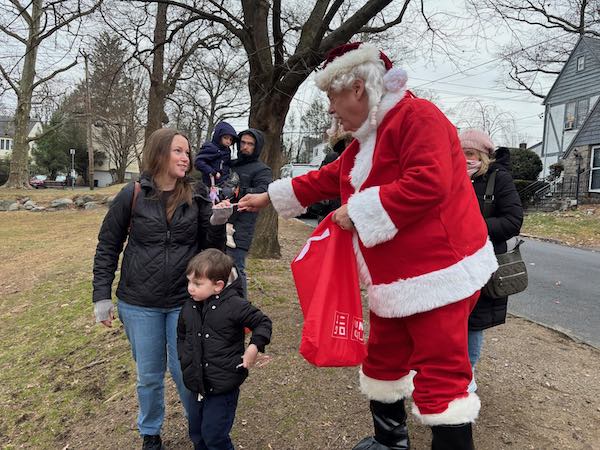
After the holiday caroling finished, the annual holiday event then included the lighting of the large pine tree in Davis Park by Arthur Manor resident Maura Danahy. The tree lights were strung earlier in the week in Davis Park under the direction of Scarsdale’s Public Works and the dedicated Pubic Works’ crew.
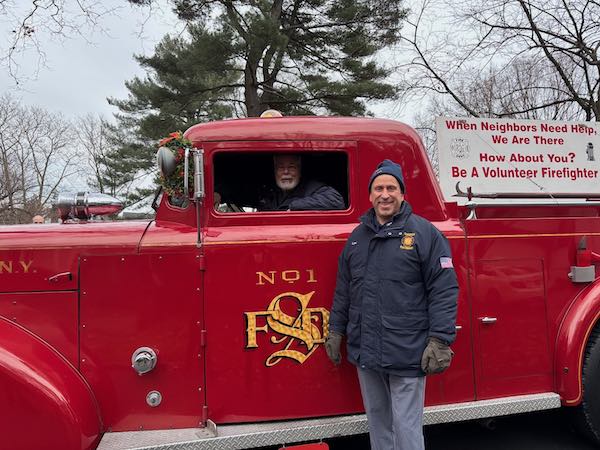
The crowd on Sunday also included Lou Mancini and many other active members of Scarsdale Volunteer Fire Company Number 1, founded on Sprague Road in Arthur Manor in 1893. Scarsdale’s Volunteer Fire Company Number 1 is an integral part of the Arthur Manor association.

Following the group sing, everyone’s all-time favorite, Santa Claus (played by long time Arthur Manor resident Rick Wingate), arrived at Davis Park in true style in an antique 1946 Scarsdale Fire Department truck driven by another long time Arthur Manor resident Michael Keating.
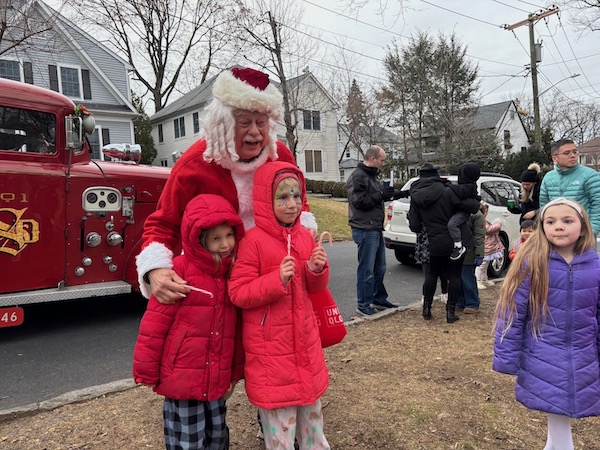
After Santa completed his rounds in Davis Park with many photographs taken and all of the candy canes handed out to the children, Santa Claus left the group at Davis Park to visit other holiday celebrations in Scarsdale and beyond.
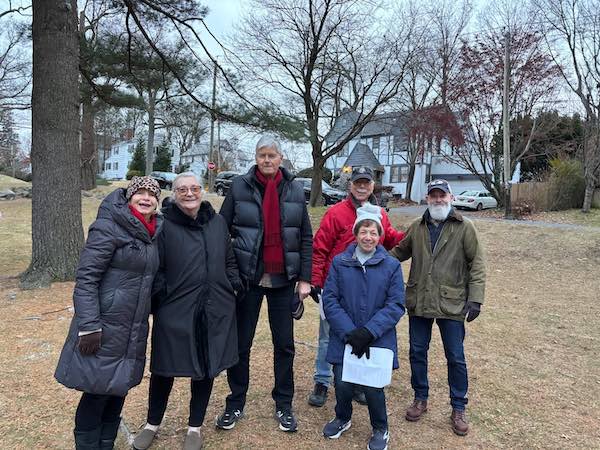
This annual festivity in Arthur Manor’s Davis Park is made possible by the collective efforts of the many Arthur Manor volunteers including especially the Marcus, Roche, Porco, Salazar, Stuart and Bongiorno families, and all of the other Arthur Manor volunteers too numerous to list here. Many good memories were made on Sunday and the Arthur Manor Board of Directors wishes to thank everyone who helped to make this year’s 95th celebration so special.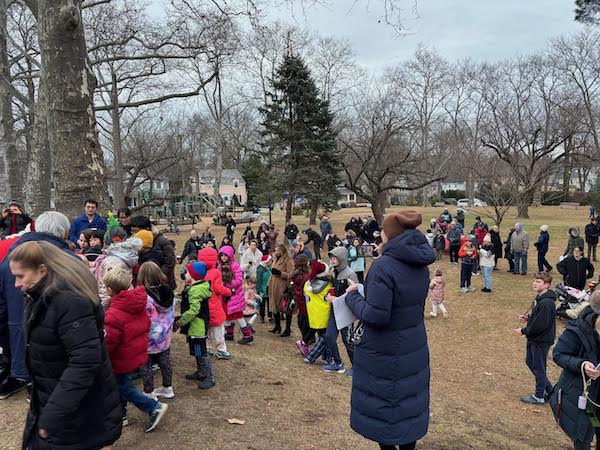
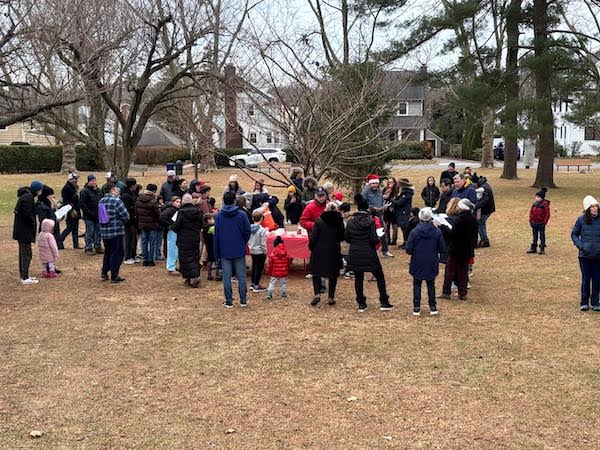
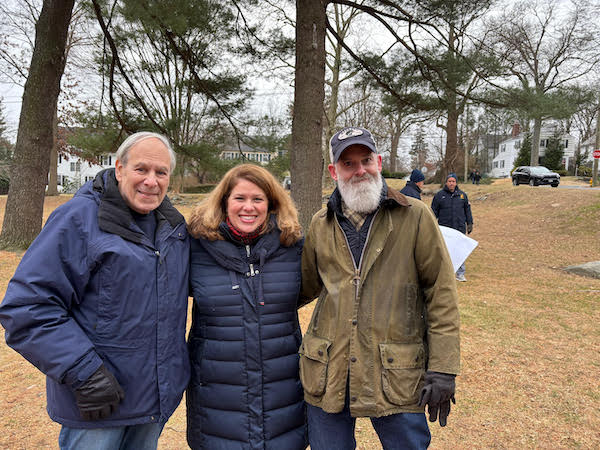
News from Village Hall: DeCicco and Sons to Open in Scarsdale Village, Weekly Recycling Pickup to Begin in January
- Details
- Written by: Joanne Wallenstein
- Hits: 11709
 (Updated 12/1/24) Two great pieces of news from the Scarsdale Village Board meeting on Tuesday November 26, 2024.
(Updated 12/1/24) Two great pieces of news from the Scarsdale Village Board meeting on Tuesday November 26, 2024.
After months of suspense, the wait is over. DeCicco and Sons, who runs the store in Eastchester, will expand into the now vacated DeCicco Family Market in Scarsdale. Plans and timing to come:
Here are comments from Mayor Justin Arest:
DeCicco and Sons
I am thrilled to announce that Decicco and Sons has entered into a contract with Decicco and Family Markets to take over the Village of Scarsdale location. Their deal is expected to close by the end of the year and we believe there will be substantial improvements to the space early next year.
The Village has been in regular contact with Scarsdale Improvement Corp. as we understand the importance of this market to many in our community including our senior population. We have expressed concerns about the hard working staff that have been impacted and have been told that actions have and will be taken to continue employment to as many employees as possible either at this location in the future or other store locations. We thank DeCicco Family Markets for its many years of service to Scarsdale and are excited to welcome Decicco and Sons to the Village Center."
Marcy Berman-Goldstein, President of the Scarsdale Business Alliance (SBA) said, “The Scarsdale Business Alliance is thrilled to welcome DeCicco & Sons to Scarsdale Village. With their outstanding reputation for quality and community engagement, DeCicco & Sons is a perfect fit for our downtown, and we are excited to see how their presence will enhance the vibrancy of the Village center.
We also want to express our deepest gratitude to DeCicco Family Markets for their many years of dedicated service to Scarsdale. Their contributions to our community have been invaluable.
As part of our ongoing Destination Scarsdale Initiative, which highlights the power of shopping, dining, and engaging locally, the arrival of DeCicco & Sons reinforces our mission to support local businesses, foster community pride, and make Scarsdale a premier destination for residents and visitors alike. We look forward to the positive impact this exciting addition will bring to our Village.”
Weekly Recycling Pick-up
Yeah - no more trips to the dump! The Village of Scarsdale will start weekly pick up of both paper and comingled recyclables in January! The service is now bi-weekly and was confusing, and also inadequate for many.
Here are comments from Mayor Justin Arest, delivered at Village Hall on Tuesday night November 26, 2024:
"It’s no surprise to our residents that sanitation collection trends have evolved over the past twenty years. While trash volumes have decreased, the collection of commingled recyclables has risen by an impressive 73%. At the same time, paper and cardboard collection has dropped by 29%. However, I want to clarify that this decline is somewhat misleading—it’s based on weight. Over the past two decades, the distribution of newspapers and catalogs has significantly diminished. These items were heavy and dense, and in their place, we now see an influx of cardboard boxes. While these boxes are often large, they don’t necessarily weigh as much.
Since before I joined the Board, residents have consistently called for increased recycling collection, particularly moving to a weekly schedule. Every Board I’ve had the privilege of serving on has explored this issue. When I became Mayor, the 2023–2024 Village Board decided to make this change a priority and this has continued. Our goal has been to enhance service while remaining as tax-neutral as possible.
This effort has involved extensive collaboration among staff, the Sanitation Department, the Teamsters Union, and many dedicated Board members. I’m thrilled to announce that, thanks to the hard work and commitment of everyone involved, the Village of Scarsdale will begin weekly recycling collection starting in January. The 2025 sanitation calendars will be sent to residents next month.
This achievement reflects our collective dedication to sustainability and responsiveness to our community’s needs. My heartfelt thanks go to all who contributed to making this goal a reality."
A Press Release from the Village of Scarsdale issued on November 26, 2024 explains:
The Village of Scarsdale is proud to announce a significant enhancement to its recycling collection program. Beginning January 01, 2025, The Village will implement weekly collection of paper and commingled recycling, replacing the current every-other-week schedule. This change reflects Scarsdale’s commitment to sustainability, operational efficiency and meeting the needs of its residents.
This improvement follows the Department of Public Works’ (DPW) operational review of the Sanitation Division, completed in December 2023. The review examined trends over the past 20 years, highlighting a notable reduction in solid waste, paper and commingled recycling collected by the Department. The findings concluded that a shift to weekly recycling services would align operations with current demand and would enhance service delivery. A copy of this study can be found here.
What Residents Need to Know:
• New Recycling Schedule: Weekly Collection of both paper and comingled recycling begins January 01, 2025.
• Sanitation Calendars: The DPW has prepared four updated sanitation calendars to reflect changes to recycling routes. These calendars will be mailed to residents before the end of the year. Nearly all residents will continue to have the same garbage collection schedule as they do now.
• Route Adjustments: To optimize recycling operations the Monday/Thursday and Tuesday/Friday trash collection routes have been divided into two recycling routes.
• Collection routes and schedules are currently being finalized and will be shared with the public ahead of the January 1, 2025, kickoff date
Affordable Housing in Westchester: LWVS Invites Experts to Explain
- Details
- Written by: Joanne Wallenstein
- Hits: 3568
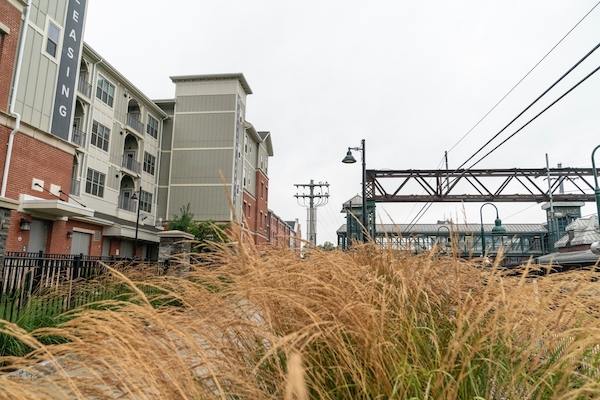 With 16,000 affordable houses needed in Westchester County and only four affordable units in Scarsdale, what can our Village do to help fill the void?
With 16,000 affordable houses needed in Westchester County and only four affordable units in Scarsdale, what can our Village do to help fill the void?
That was the subject of a luncheon sponsored by the League of Women Voters of Scarsdale on Monday November 18 at the Scarsdale Library. Fall Food for Thought Event. The discussion was led by Tiffany Zezula, Esq. is the Deputy Director for the Land Use Law Center at Pace University School of Law in White Plains with presentation by Terry Fleishman of the Westchester County Department of Planning and Rose Noon, Executive Director of the Housing Action Council.
Reviewing the data Fleischman defined affordable in terms of the ratio between gross household income and the monthly rent or monthly expense for a homeowner. For rentals that’s defined as 30% and for owners, 33%.
The county has estimated that 16,007 more affordable household units are needed for the almost 1,000,000 people living in and commuting to Westchester for work. A lack of available infrastructure and lack of financial support is hampering efforts to fill this void.
She said, “The cost of housing is a significant barrier to attracting a skilled work force to Westchester. More workers commute into the county than live and work here and more affordable housing would make our economy more competitive. All types of housing are needed: starter homes, homes for families, homes for downsizers and homes for seniors.”
Noonan reviewed the status of affordable housing in Scarsdale, where there are only 4 units among 5,700 households. Two are in the Ambassador, a senior living facility on Saxon Woods Road, one at the new development at The Heathcote and the last is a Village owned home.
She noted that Scarsdale’s comprehensive plan requires the inclusion of an affordable unit in multifamily projects of 5-9 units and in subdivisions of 10 or more homes.
Around Westchester she sited work being done to bring affordable housing to communities.
In Dobbs Ferry there are plans to use a municipal parking lot and another small site to create housing. Residents put out an RFP to developers, and are currently reviewing proposals and hope to get approval to build. Near the trains station in the Village of Ossining, there is a “Brown Field” that Con Edison needs to remediate and will then be used to build affordable housing.
Pleasantville has passed an affordable housing ordinance and built a few new developments with a small number of affordable units. They also purchased condo units at market price and reduced that to affordable prices.
Tiffany Zezula explained that there are no affordable housing quotas to be met by municipalities so the onus is on the community to do the right thing. Subsidies from the state and county are limited so the best way to construct affordable housing is in partnership with private developers who receive incentives through tax credits for building affordable units.
In Scarsdale, the Municipal Services Committee of the Scarsdale Forum is currently urging the Scarsdale Board of Trustees to re-open discussions about the development of the Freightway Site. This could include both market rate and affordable units as well as parking, retail space and community facilities. They contend that the development would meet many Village needs. First, the Freightway Parking garage is beyond its useful life and requires significant investment to remain open. The development would provide housing for current residents seeking to downsize or newcomers looking for a more affordable way to live in Scarsdale. Village retailers would benefit from more foot traffic from those living near the Village Center and the project would serve to revitalize Scarsdale. The Village embarked on a process to develop the site before COVID, but it was dropped when the community failed to reach consensus.
Learn more about their proposal here.
Trustees Unveil Schematic of Reimagined Pool Complex
- Details
- Written by: Joanne Wallenstein
- Hits: 4969
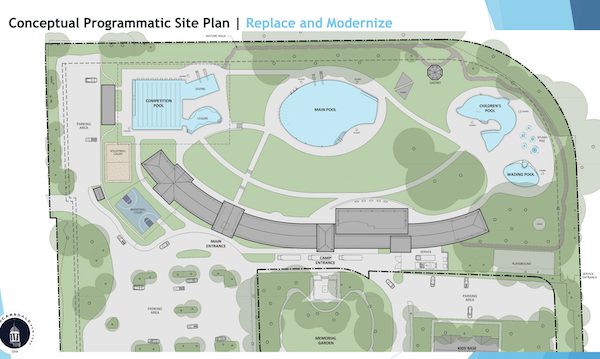 We’ve known for years that the beloved Scarsdale Pool Complex has outlived its “useful” life, but what should replace it? Earlier this year, Mayor Justin Arest announced that the old pool complex would be open this summer for the 2025 season, and that construction on the new complex would begin in September 2025.
We’ve known for years that the beloved Scarsdale Pool Complex has outlived its “useful” life, but what should replace it? Earlier this year, Mayor Justin Arest announced that the old pool complex would be open this summer for the 2025 season, and that construction on the new complex would begin in September 2025.
The question is, what will be built? And at what cost?
After years of studies, public forums, surveys and meetings, the Scarsdale Village Trustees unveiled a program design for the replacement of the Village’s 56 year-old pool complex at a work session with stakeholders including the consultants, the Village staff and pool committee members on Tuesday October 29, 2024.
Deputy Mayor Dara Gruenberg explained, “We did not seek out this project – it was handed to us. We are passing the baton forward and we are acting as stewards for the Village in their work to preserve a beloved community asset.” She added, “This project was inherited from former Boards and will not be completed until many members of the current Village Board have moved on.”
Trustee Karen Brew reiterated that the pool complex is beyond repair. The equipment is obsolete and the facility does not meet health and safety codes. When mechanical parts break, they are no longer available for purchase. And once one part is repaired, the entire complex would need to be brought up to code.
Therefore, a re-imagined complex is in the works.
The purpose of this week’s meeting was to review a conceptual programmatic site plan to replace and modernize the pool complex. The plan took into account all the feedback the consultants received and incorporated as many elements as possible into the concept for a four-pool complex to accommodate all generations of the community. The Mayor stressed that this was a conceptual plan and that nothing has yet been decided.

Larry Medvinsky who is the Chair of the PRC and the Pool Advisory Committee told the group that the Village surveyed residents and that over 90% of respondents were current or former pool members. The outcome of the outreach was that people love and value the pool. It also attracts new residents and helps preserve home values.
What’s In the Plan?
He presented the schematic and highlighted some of the features of the proposal:
Recognizing the need to accommodate all segments of the community, the complex will include features such as a zero-entry pool to ease entry into the water, a leisure pool for adults, a dolphin shaped children’s pool and a clam shell shaped wading pool for Scarsdale’s youngest residents. A competition lap pool and diving pool will accommodate swimmers and divers. In between the two children’s pools will be a splash pad, guaranteed to delight kids of all ages. The four pools will be heated.
The expanded building will have separate locker rooms men, women and families along with another separate facility for the day camp so that the main locker rooms are not overwhelmed by the camp population. There will also be a main entrance and another camp entrance to ease access during the weeks when the Recreation Camp is in season. For those wishing to store their pool chairs and equipment, seasonal locker pods would be available. There would also be an indoor multi-purpose rooms for activities, games and meetings.
The consultants discussed the possibility of a more extensive food concession stand or restaurant with the access to the community without entrance to the pool. This would permit those using the fields or courts nearby to stop in for a bit. Separate entry could also be permitted for use of the Volleyball and Basketball courts which would be located on the Boulder Brook side of the site.
Responding to those who wish to retain the complex’s park-like field, the plan includes plenty of grassy areas as well as shaded areas for relaxation. A gazebo would provide more shade and a site for gatherings.
For those who called for a year-round indoor pool, the consultants are leaving a further option open. The separate lap and diving pool could be “domed” or enclosed down the line, making it usable year-round.
How Much Will It Cost?
What is the price tag? The longer the Village waits to start, the higher the price goes up. The estimate for this plan, without the indoor option is $41 mm. The Village would need to issue bonds to finance the work. That would translate to a $504 increase in the Village tax portion of the average household’s bill for the next 20 years.
The consultants also provided an estimate of $2 to $12 to enclose the lap pool and diving area, depending on the type of enclosure that was used. For this option, the storage building next to the competition pool would need to be replaced with a two-story winterized structure to house heated bathrooms, changing rooms and a multipurpose room.
Public Comments
Trustee Karen Brew invited attendees to give public comments. The majority of the audience were seniors who wanted to repair rather than replace the pool complex, despite the explanation of why this cannot be done.
Susan Levine said she has lived here since the pool was built. She said, “The rest of thetown will not be seduced by anything you do. The people who join don’t have summer homes. We love the pool. The people who enjoy it want it to stay as is –and maintain the feel.”
Marion Green – Chair of Council for People with Disabilities asked for some features for the handicapped. She said, “We need handicapped parking, handicapped bathrooms, sinks and soaps, non-slip floors, Vehicles currently go through the Little School – that’s dangerous. The walk up from the pool is difficult. Will there be quiet space?”
Marian Schoen of 28 Springdale Road said, “We have been members since 1978.I would like you to list why the pools as they are cannot be repaired and changed. The $500 increase in taxes is quite significant. What do you expect the membership fee would be?
Yes this looks beautiful. I do think there have to be some changes but why can’t you start from what you have and improve that? This community should have an indoor facility – but why can’t you stop with what you have?”
Mayor Arest explained explained again why the current facility is not up to code and cannot be simply upgraded. He added, “We are trying to create an atmosphere where more residents will want to use the pool.” Trustee Jeremy Gans added, “If you make any modification to a pool facility, the entire facility must be up to code. That’s why this is a big project.” Bill Simmons from Lothrop Associates said, “The equipment is obsolete. It has outlived its useful life. If we keep going, the pools will have to be closed. The risk is that it will go out of commission entirely.”
Myra Saul of 5 Lincoln Road said she has lived here for 35 years. She said, “We love the pool. We are there almost every day in the summer. It is our summer backyard. I accept that the pool needs to be rebuilt. Enhancements should be reasonable and cost effective. There have been on and off discussions about making the pool a full time facility. Maybe the high school would be using the pool for practice. Can the school chip in? The pool is an inducement to stay here after the children move on. That costs money!”
Scott Mishara of 216 Nelson Road said, “It’s obvious that we need the new pool. I am in favor of a new pool. Thank you for all the hard work.” He questioned whether or not the diving boards should be next to the lap swimmers and said, “I think people should be able to afford $500 a year for the community.”
Joan Uchitelle – 11 Ridgecrest West said, “I am concerned about the non-resident members of the pool - what is the number of non-resident members? People are not using it.” The Mayor replied, “That’s the reason we want to enhance the pool – to bring people back.”
Trustee Sameer Ahuja added, “When you have an old facility fewer people will go. If we invest, we can get 500 more people to join the pool.” He did a quick financial analysis to show how it would enhance home values.
He said, “The current assessed value of homes in Scarsdale is about $9bn. A 40M pool project represents 0.5% of this total value. House values go up 3-5% a year on average. In 20 years, the possible life of the bond for the pool, the value of homes in Scarsdale could very well be $14Bn. Many public sources suggest that pools contribute anywhere from 3-7% to the value of homes in a community. If you assume that value contribution is 5%, that is means the pool could contribute $250M to values of our homes. Even if you don’t believe it is that high, let’s say it’s 1% contribution. Even that is $50M, which pays for the potential cost of the pool.”
A resident named Monica said that the pool was one of the reasons her family moved to Scaarsdale. She said, “There is no solution that will make everyone happy – but what is the timeline to make this decision? The plan as of now is to start construction in September 2025.?
Meredith Lonner said she has lived here her whole life and that she is thrilled with the plans for the new pool.”
Alan Garfunkel said, “We need 15 lap lanes - and I don’t want diving in the same area. And if you are going to make it an indoor pool the locker rooms will need to be heated.”
Barbara Greebel of 40 Tompkins Road saod she has lived here since 1958. She posed many questions. “What is the gazebo? Where is the snack bar going to be? What is the present capacity of the large pool and what will be the capacity of the new pool? Where is the zero entry area? What is the grading – right now it is too steep.”
Anne Moretti of 10 Pinecrest is a member of the Council on People with Disabilities. She was happy to see recognition of “empty nesters,” or “free birds.” She said, “Thanks to the committee for spending hours evaluating every iteration.” As a real estate agent she said, “Do the math – there will be an increase in the equity growth of your house for whoever inherits it. A state of the art pool facility is a game changer. I always take prospective buyers to the pool. It will improve the quality of life.”
Harris Sokoloff of 350 Heathcote Road said, “I want to say how impressed I am. I have three kids under 6 years old. I like the pools for the kids and the rental lockers. I don’t think you’re adding enough features to bring more people to the pool. I would suggest you look at further enhancements. We should let people from surrounding neighborhoods like Wilmot Woods join the pool. I am against the indoor pool – it’s a financial burden and we can’t get life guards.”
Take a look at the entire presentation on the Village website here and give your input on the plan by emailing [email protected].







